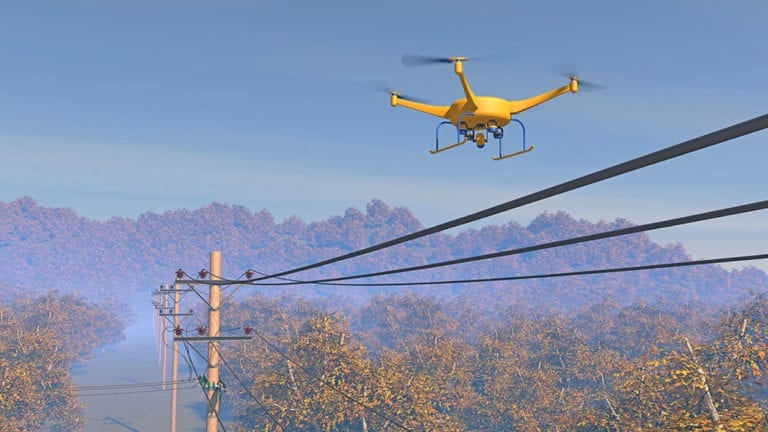6 min read
August 25, 2022


Christos Ruci
3 Articles
Author's Articles

Christos Ruci
3 Articles
Drones
Utilities
Inspection
Maintenance
Ever since the Federal Aviation Administration (FAA) eased restrictions on using commercial drones, drones have become indispensable assets for many industries. From expediting product deliveries to expanding disaster relief aid, drones are practical, flexible and cost-effective solutions for many job functions—especially ones that are deemed time-consuming or dangerous.
But if there’s any sector that has shown immense potential for drone technology, it’s the energy industry. With jobs that frequently require line workers to place themselves in risky situations, drones are proven game-changers—able to inspect potentially dangerous worksites for a fraction of the cost and without the safety hazards.
Here are four reasons why drone technology is taking off in the energy industry:
Drones are Viable Options for Reducing Costs
Routine power line and transmission inspections can cost a utility company hundreds of thousands of dollars a year after labor, equipment and downtime for inspections are factored in. But now, there’s a more effective and less expensive alternative to manual inspections: Drones.
Unlike manual inspections, drones can cover large inspection areas quickly using LiDAR-technology, which uses advanced sensors to map land, measure the health of lines and even help manage surrounding vegetation. These drones can fly the length of transmission lines, capturing the same data that, historically, could only be captured by line workers climbing poles or performing aerial inspections from helicopters—two notoriously expensive, time-intensive tasks.
But the cost savings aren’t just limited to inspections. Drones can even be used to survey sites and routes prior to an inspection, helping line workers determine the safest, fastest route for a job. And, instead of turning the power off while line workers conduct inspections, drones can perform inspections while the power remains on—reducing the costs of downtime and preventing service interruptions.
Of course, the price of a drone can vary wildly depending on its capabilities—but an upfront investment in a drone can offset the cost of ongoing manual labor costs, resulting in greater cost savings over time.
Drones Mitigate Safety Risks on Dangerous Jobs
Whether it’s inspecting wind turbines that are hundreds of feet tall or accessing unstable natural disaster sites, line workers are often tasked with potentially dangerous work responsibilities. But drones—which can perform aerial inspections with even greater precision than manual inspections—can help mitigate these risks.
For example, after Hurricane Maria ravaged Puerto Rico in 2017 and left its electrical system in pieces, Duke Energy turned to drones to help restore the infrastructure. Instead of sending out crews, Duke Energy flew drones over mountainous terrain and deep ravines to search for broken poles, downed power lines and safer pathways for crews. Workers even helped restore power by using the drones to carry lightweight cords and restring power lines.
In 2016, Con Edison also began testing the use of drones in inspecting 10-story-high boilers in an effort to reduce costs, time and safety risks. Inspecting the 10-story-high boilers—which produce steam for many of New York City’s most iconic buildings—previously required workers to build tall scaffoldings and go through confined-space training. Using thermal, video and camera technology, the drones can fly all around these boilers, capturing real-time images for quick analysis and identifying potential repairs—all without endangering lives.
By equipping crews with drones, line workers no longer have to be subject to dangerous heights, live wires or unstable surfaces—and they don’t have to sacrifice the quality of inspections, either.
Drones Inspire a Proactive vs. Reactive Approach
During ground inspections, line workers often rely on their judgment to determine the health of a tower or pole. If there’s a visible defect, or any other sign that the infrastructure is in poor health, this indicates that they need to climb the tower or pole for further inspection. The problem is, this method leaves room for error; tiny leaks or infrastructural damage can be easily overlooked and lead to a costly failure.
With a bird’s eye view and 3D imaging capabilities—which can capture details on everything from hardware codes to surrounding vegetation—drones can help eliminate the guesswork associated with maintenance and inspections. Drones can capture and transmit real-time images, which can be stored and compared over time to monitor asset health and assign maintenance as needed. Additionally, some drones have thermal imaging technology, which can help detect natural gas pipeline leaks or solar panel issues that are invisible to the naked eye.
Since 2017, Duke Energy has used drones with infrared cameras to help technicians identify faulty panels in solar plants. Hotter panels appear more yellow than surrounding panels, which indicates if the panels aren’t effectively converting solar energy into electrical energy. And, depending on the number of panels that are affected, these bright spots help workers determine if the problem is a singular faulty panel or an electrical issue.
By identifying issues early-on—like loose cables, missing screws, infrastructure damage or leaks—drones allow energy companies to take a more proactive versus reactive approach and prevent extensive failures or damage. Energy companies can use the data acquired from drones to target their predictive maintenance programs, setting up routine inspections based on the condition of their assets—not just an educated guess.
Drones & Utilities: A Bright Future Ahead
From improving safety to reducing operational costs, we’re just beginning to scratch the surface of possibilities of using drones in the energy industry. But arguably the most impressive aspect of a drone is the software that powers it—not just its flying maneuvers.
Stay tuned for our next blog, where I’ll dive into key considerations—like industry regulations, drone costs, drone software capabilities and more—to help you determine the best course for implementing drones in your organization.
In the meantime, check out our blog for more insights on emerging technology, custom software and the power of data analytics.
This blog was a collaboration between Christos Ruci and Lane Manoosingh.
Share this content: